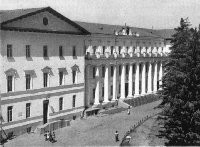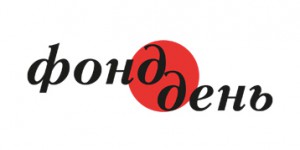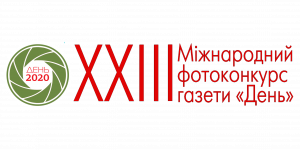By Valentyna KUZNETSOVA
"It has been common practice in our town for so long under any regime,
if I may add, to trade on a vast square on Sundays. Peasants would come
from neighboring villages carrying cattle, fowl, and vegetables, while
our town dwellers would go, baskets and bags in hand, past the horse-carts
asking prices, feeling everything with their hands, bargaining, or simply
conducting a good talk which might last for hours and all too often ended
up with fist-fighting. Even in hungry years the Sunday gatherings went
on uninterrupted" (Yu. Sliozkin, A Goat in the Garden, 1927).
This is already the twilight of the famous Nizhyn bazaar as depicted
in the 1920s, a few years before the famine and the demise of the Ukrainian
economy.
Today's shuttle traders, who have flooded the market in Nizhyn as everywhere
else with foreign goods, are inheriting unknowingly the traditions of an
old town which used to send its merchants to far-away countries and accord
a hospitable welcome to foreign traders at their fairs.
From the mid-seventeenth century on, fairs were held three times a year:
the Feast fair in winter, the Trinity fair in summer, and the Veil of the
Holy Virgin fair in the fall. Each lasted two or three weeks. There were
also twice-a-week auctions.
Nizhyn demonstrated all its splendor at such fairs. Bars and inns would
be crammed with visitors. Tobacco and spices were brought from Turkey and
Bulgaria, haberdashery from Germany, furs from Moscow, porcelain from Leipzig,
velvet, silk, wool and cotton print from Venice and KЪnigsberg, Dutch,
English, and French woolens textiles from Gdansk. Local Greeks amazed the
public with sausages, peasants from Nizhyn and adjacent villages brought
cherries, plums, watermelons, pears, mushrooms, and tobacco. Grapes came
from the South, salt and fish from Astrakhan. Wines were mostly of Hungarian
or Crimean make.
The fairs exported the works of goldsmiths and the products of local
furriers. Local pickles have been famous since the eighteenth century:
over 600 tons of these were stocked up every year for sale. Annual sales
featured 8,000 tons of the Nizhyn tobacco (brought from Holland, it soon
became popular. Its name, makhorka, derives from the corrupted phrase "from
the city of Amersfort, Amophora tobacco").
Prince I. M. Dovhoruky, who visited Nizhyn in 1810, advised: "Let those
who like liqueurs come here: they are good; Nizhyn takes a legitimate pride
in its various vodkas; I bet there are no such varieties anywhere else!"
Nizhyn's commercial glory was very much contributed to by the Greeks
who had been settled since the days of Bohdan Khmelnytsky. It was Ukraine's
largest Greek community. Thanks to Khmelnytsky's Universal (Decree) of
May 2, 1657, and decrees of successive Hetmans, Nizhyn Greeks had many
privileges: they paid no taxes, they were automatically equated with first-
and second-guild merchants; they were exempt from quartering soldiers,
consigning horse-carts to the army, and from military service (i.e., they
did not lose sons in wars, nor did they suffer from devastation); if they
still joined the army they enjoyed the rights of the nobility. Nizhyn's
Greek population had its own magistrate. In 1710 Peter the Great confirmed
all the Nizhyn Greeks' privileges. It is still anyone's guess why the Greeks
should have been granted so many privileges, especially in taxes, which
enabled them to quickly stand on their feet and develop their business.
Why did Ukrainians have no tax concessions? Is mistrust to their own people
really a distinctive feature of our politicians in all times?
Out of Nizhyn's first well-known merchants, let us remember the almost
forgotten names of Ivan Sheremetsov and Dmytro Tsypoyev, the latter hailing
from the Nizhyn Greeks. Ivan Sheremetsov arrived in Nizhyn from his native
Sievsk, Orel region, and, joining his capital with that of Tsypoyev, decided
to start trade with Persia. Tsypoyev was the first to set out to the faraway
land in 1747. After traveling for 8 years, he died in India. Ivan Sheremetsov
learned about his partner's death only 13 years later. Trying to return
his capital, he made a deal with Mykola Chelobytchykov who had the courage
to go to India.
The road to Indian markets was not easy: Nizhyn - Kyiv - Jaszi - Bucharest
- Istanbul - to Baghdad on the Tigris - to the Euphrates by land - to Calcutta
across the Persian Gulf. It took a year to reach India and four to come
back. Chelobytchykov decided to increase his capital by purchasing hitherto
unknown goods in Canton (China) and Malacca.
The medieval Malacca was called the Golden Chersonesus; Columbus strove
to get there in the late fifteenth century but, losing his way, he found
himself in America instead. The itinerary to those unknown, almost fabulous,
commercial cities proved to be more correct from Nizhyn. Today we can fully
appreciate the event: Chelobytchykov became our first, and for many decades
the only, compatriot to visit Malacca and Canton.
In August 1805 Canton was visited by another person hailing from Nizhyn,
Yuri Lysiansy, captain of the Neva, which was making the first Russian
circumnavigation of the globe. One of the goals of the voyage was to prospect
for new markets. Canton, as before, sold what the Slavs had never heard
of: amber, musk, ivory, sandalwood, ebony, and quicksilver.
Nizhyn provided not only merchants - bold, far-seeing and risk-taking
- but also statesmen people. They understood the importance of new Eurasian
markets for their country's economy. Chelobytnykov headed from China for
London, Lisbon, and Paris. He finally arrived in Saint Petersburg with
a most detailed report on the capacity of national commerce, and then disappeared.
Nothing else is known about him and his project. The Nizhyn market never
saw the unusual goods of the Golden Chersonesus.
Nizhyn's being situated on the Kyiv-Moscow trade route determined for
several centuries the importance of the town as one of the Russian Empire's
chief commercial centers. "Nizhyn is not only part of Chernihiv province.
It is what may be called the only commercial city in Little Russia which
is not inferior to many Great Russian cities, as far as trade is concerned.
Not only during fairs but at any time one can find here various household
and everyday-life items" (eighteenth century historian A. Shafonsky). Nizhyn
traded primarily with Turkey, Poland, and Moscow, as it also does today.
In the second half of the nineteenth century, when new trade centers
emerged in Ukraine, the Nizhyn fair was of a great local importance. "There
were times when this dirty and now insignificant township was also brimming
with life. What is left are only reminiscences of its past glory" (L.Slutsky,
late nineteenth century).
There have been attempts in the past few years to restore the town's
commercial status. The Veil of the Holy Virgin Fair is again held in the
fall, but only for one day. Exquisite imported goods have given way to
the traditional shuttle-trade consumer items. On the other hand, the town
is visited by masters and traders (shall we call them merchants soon?)
from Kyiv, Poltava, Kolomiya, and Myrhorod.







